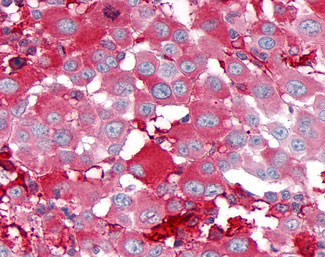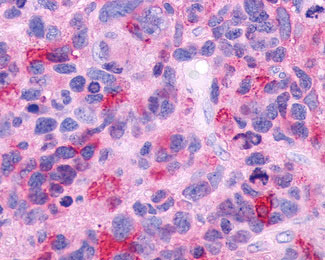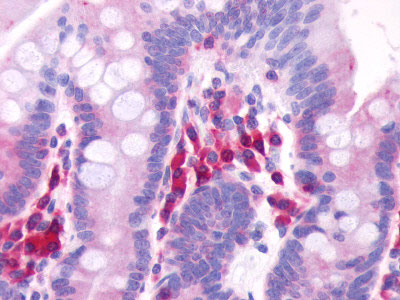GPR39 Antibody (Extracellular Domain)
Rabbit Polyclonal Antibody
- SPECIFICATION
- CITATIONS
- PROTOCOLS
- BACKGROUND

Application
| IHC-P |
|---|---|
| Primary Accession | O43194 |
| Reactivity | Human, Mouse, Rabbit, Horse |
| Host | Rabbit |
| Clonality | Polyclonal |
| Calculated MW | 51kDa |
| Dilution | IHC-P (1.25-2.5 µg/ml) |
| Gene ID | 2863 |
|---|---|
| Other Names | G-protein coupled receptor 39, GPR39 |
| Target/Specificity | Human GPR39. BLAST analysis of the peptide immunogen showed no homology with other human proteins. |
| Reconstitution & Storage | Long term: -70°C; Short term: +4°C |
| Precautions | GPR39 Antibody (Extracellular Domain) is for research use only and not for use in diagnostic or therapeutic procedures. |
| Name | GPR39 |
|---|---|
| Function | Zinc-sensing receptor that can sense changes in extracellular Zn(2+), mediate Zn(2+) signal transmission, and participates in the regulation of numerous physiological processes including glucose homeostasis regulation, gastrointestinal mobility, hormone secretion and cell death (PubMed:18180304). Activation by Zn(2+) in keratinocytes increases the intracellular concentration of Ca(2+) and activates the ERK/MAPK and PI3K/AKT signaling pathways leading to epithelial repair (PubMed:20522546). Plays an essential role in normal wound healing by inducing the production of cytokines including the major inflammatory cytokine IL6 via the PKC/MAPK/CEBPB pathway (By similarity). Regulates adipose tissue metabolism, especially lipolysis, and regulates the function of lipases, such as hormone-sensitive lipase and adipose triglyceride lipase (By similarity). Plays a role in the inhibition of cell death and protects against oxidative, endoplasmic reticulum and mitochondrial stress by inducing secretion of the cytoprotective pigment epithelium-derived growth factor (PEDF) and probably other protective transcripts in a GNA13/RHOA/SRE-dependent manner (PubMed:18180304). Forms dynamic heteroreceptor complexes with HTR1A and GALR1 depending on cell type or specific physiological states, resulting in signaling diversity: HTR1A-GPR39 shows additive increase in signaling along the serum response element (SRE) and NF-kappa-B pathways while GALR1 acts as an antagonist blocking SRE (PubMed:26365466). |
| Cellular Location | Cell membrane; Multi-pass membrane protein |
| Tissue Location | Expressed in many tissues, including the stomach, intestine and hypothalamus. |
| Volume | 50 µl |

Thousands of laboratories across the world have published research that depended on the performance of antibodies from Abcepta to advance their research. Check out links to articles that cite our products in major peer-reviewed journals, organized by research category.
info@abcepta.com, and receive a free "I Love Antibodies" mug.
Provided below are standard protocols that you may find useful for product applications.
Background
Zn(2+) acts as a agonist. This receptor mediates its action by association with G proteins that activate a phosphatidylinositol-calcium second messenger system. Its effect is mediated mainly through G(q)-alpha and G(12)/G(13) proteins. Involved in regulation of body weight, gastrointestinal mobility, hormone secretion and cell death (By similarity).
References
McKee K.K.,et al.Genomics 46:426-434(1997).
Kaighin V.A.,et al.Submitted (OCT-2008) to the EMBL/GenBank/DDBJ databases.
Ota T.,et al.Nat. Genet. 36:40-45(2004).
Hillier L.W.,et al.Nature 434:724-731(2005).
Storjohann L.,et al.Biochemistry 47:9198-9207(2008).
If you have used an Abcepta product and would like to share how it has performed, please click on the "Submit Review" button and provide the requested information. Our staff will examine and post your review and contact you if needed.
If you have any additional inquiries please email technical services at tech@abcepta.com.













 Foundational characteristics of cancer include proliferation, angiogenesis, migration, evasion of apoptosis, and cellular immortality. Find key markers for these cellular processes and antibodies to detect them.
Foundational characteristics of cancer include proliferation, angiogenesis, migration, evasion of apoptosis, and cellular immortality. Find key markers for these cellular processes and antibodies to detect them. The SUMOplot™ Analysis Program predicts and scores sumoylation sites in your protein. SUMOylation is a post-translational modification involved in various cellular processes, such as nuclear-cytosolic transport, transcriptional regulation, apoptosis, protein stability, response to stress, and progression through the cell cycle.
The SUMOplot™ Analysis Program predicts and scores sumoylation sites in your protein. SUMOylation is a post-translational modification involved in various cellular processes, such as nuclear-cytosolic transport, transcriptional regulation, apoptosis, protein stability, response to stress, and progression through the cell cycle. The Autophagy Receptor Motif Plotter predicts and scores autophagy receptor binding sites in your protein. Identifying proteins connected to this pathway is critical to understanding the role of autophagy in physiological as well as pathological processes such as development, differentiation, neurodegenerative diseases, stress, infection, and cancer.
The Autophagy Receptor Motif Plotter predicts and scores autophagy receptor binding sites in your protein. Identifying proteins connected to this pathway is critical to understanding the role of autophagy in physiological as well as pathological processes such as development, differentiation, neurodegenerative diseases, stress, infection, and cancer.




